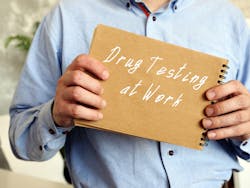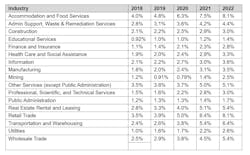Revealing new statistics and a long-awaited new set of government rules could foreshadow the arrival of a new day in workplace drug screening.
With data from a leading lab testing firm suggesting worker drug usage is on the rise and a government agency clearing a path for an alternative to urine testing for safety-sensitive workers, the future for one specific type of drug testing – oral fluids-based – is suddenly looking brighter. Broader adoption of that nascent method could bring more speed, convenience, and clarity to workplace drug testing, potentially benefitting industries like construction, where testing logistics can be challenging, and drug impairment is a potent safety concern.
A headline finding from Quest Diagnostics’ latest analysis of test results on urine samples it handles is that marijuana positivity for general workforce workers – those not in select government or private sector safety-sensitive jobs subject to mandated routing testing – involved in workplace accidents hit a 25-year high in 2022. Of all samples tested, 7.3% came back positive for marijuana. That was a 9% increase from 6.7% in 2021 and a notable uptick within in an upward trend evident since 2012. The marijuana figures stand out, but so do those showing nearly 5% of all Quest-analyzed workplace urine drug tests again came back positive in 2022, up 30% in a decade.
While eye-catching, the marijuana data, says Suhash Harwani, Ph.D., the firm’s senior director of science for employer solutions, must be carefully parsed for meaning.
“It’s a concern that positivity is going up post-accident, but correlation is not causation,” he emphasizes. “It’s only suggestive of a link, partly because there’s no standard for impairment with marijuana like there is for alcohol.”
What can be said with more certainty, Harwani says, is that the data likely reflect broader marijuana usage by the public, something to be expected given the steady trend toward legalization in states. Moreover, because urine tests can’t identify proximate usage that could point to impairment, the statistics likely gather in many occasional users who simply have inert traces of the drug in their systems.
Indeed, additional Quest data point to growing marijuana usage; samples from all of Quest’s marijuana testing from the general workforce – not just post-accident – showed 4.3% positivity in 2022, up from 3.9% in 2021, and positivity was notably higher in tests conducted in states where marijuana is legal. And in each of 17 industry sectors, general workforce positivity for marijuana from all urine samples was up in 2022, ranging from 1.4% to 8.1%. (Construction was at 3%, up from 2.9% in 2021). And all sectors show increases from 2018, many rates doubling or even tripling over that stretch (see Table).
Marijuana usage trendlines could pose an emerging dilemma for employers that only tests capable of detecting recent usage – and perhaps impairment – can help address. And that’s where oral-fluids testing comes in.
Compared to urine or hair testing, it has demonstrated notably higher positivity overall for marijuana, Harwani says, and also better flags recent use, which could be more definitively linked (along with other evidence) to possible impairment. In a world where legal marijuana usage is growing and employers thus face obstacles in weeding out users, narrower testing for signs of on-the-job intoxication/impairment that can be woven into company policies becomes more critical.
That bodes well for oral-fluids testing, as does its ease of use, and usage has been growing. A boost could come from the U.S. Department of Transportation’s May 2023 decision to move further down the path of allowing oral-fluids testing to be used in drug screens it mandates for a broad contingent of workers in safety-sensitive roles. An eventual approval, expected in 2024, could be a strong signal to general workforce employers that it’s a sound option.
“It will make even those employers less likely to move away from urine testing more likely to go to oral-fluids testing,” says Harwani. “The DOT move could help stragglers over that hurdle.”
Tom Zind is an independent analyst and freelance writer based in Lees Summit, Mo. He can be reached at [email protected].
About the Author
Tom Zind
Freelance Writer
Zind is a freelance writer based in Lee’s Summit, Mo. He can be reached at [email protected].

